Statistics on Working Children
and Hazardous Child Labour in Brief
Kebebew Ashagrie
International Labour Organization
Bureau of Statistics
Geneva, October 1997
I. WORKING CHILDREN
1. Introduction
It is common knowledge that data on child labour are extremely scarce. The reason for
this is the absence of an appropriate survey methodology for probing into the work of
children which, for the most part, is a "hidden" phenomenon. Consequently, the
ILO designed special sample survey methodologies and experimented them in four countries.
These were further refined and adopted for investigating at the national level the child
labour situation in a number of countries.
The child labour problem being multi-dimensional, the information sought through the
specialised survey approaches involved answers to the following questions, among others:
Who are the working children and how many are there in the individual countries?
How old are they when they start to work for the first time and how do they live?
Why do they work and in which sectors are they engaged?
What are their specific occupations and the conditions of their work?
What types of exploitation and abuse they face at work?
How safe are they physically and mentally at their workplace or in their occupations?
Do they also go to school? If they do, what are the consequences of their non-schooling
work? And if they do not go to school, what are the reasons?
Who are their employers? Why do they use them? And how do they treat them in comparison
with their adult workers?
How many children are engaged on a full time basis in housekeeping activities of a
purely domestic nature in their own parents' or guardians' households thereby sacrificing
their education and also exposing themselves to various injuries and health hazards?
What are the perceptions of parents about their working children? What are those of the
children themselves and their employers?
Based on the findings of the experiments as well as the results of national surveys
carried out since then using the newly developed methodologies and, also taking into
account other demographic and socio-economic factors, the ILO produced estimates on the
size of working children at regional and global levels which have been internationally
accepted and quoted as ILO figures. Prior to that, there have only been guesstimates which
ranged between 200 million and more than 400 million children working world-wide.
2.
Level and distribution of working children
General level
According to the new estimates, there are some 250 million children 5-14 years old who
are toiling in economic activity in developing countries. For close to one-half of them
(or 120 million), this work is carried out on a full time basis, while for the remaining
one-half it is combined with schooling or other non-economic activities. Among school
going children, up to one-third of the boys (33%) and more than two-fifths (42%) of the
girls are also engaged in economic activities on a part-time basis.
The overall estimates of 250 million working children are exclusive of children who are
engaged in regular non-economic activities, including those who provide services of
domestic nature on a full-time basis in their own parents' or guardians' households.
The number of such children is relatively large (about 15%-20% of the total child
population of the same age-cohort).
Gender
The data so far obtained show that more boys than girls work ¾ close to three boys to
two girls, on average. It should be borne in mind, however, that the number of working
girls is often underestimated by statistical surveys which usually do not take into
account unpaid economic activity carried out in and around the household, including
household enterprises.
Also more girls than boys perform full-time housework of non-economic nature - e.g.,
housekeeping in their own parents' household - many of them between 8-12 years old - in
order to enable their parents or guardians to go to work, or to take care of sick or
handicapped members in the household. Such work is reported to be the main reason for
about one-third of the youngsters who do not attend school - they were either never
enrolled or were obliged to drop out of school because of the full-time housework. If such
full-time housework were taken into account, there would be little or no variation between
the sexes in the total size of working children, and the number of girls could even exceed
that of boys.
Regional
For obvious reasons, child labour is most prevalent in the developing regions of the
globe. In absolute terms, it is Asia (excluding Japan), as the most densely populated
region of the world, that has the most child workers (approximately 61% of the world's
total as compared with 32 % in Africa, 7% in Latin America, and one-fifth of one per cent
in Oceania excluding Australia and New Zealand). But in relative terms, Africa comes first
in economic activity participation rate of children which is estimated at a little more
than two children out of five (or 41%) of the total children 5-14 years old. The
corresponding proportion in Asia is around one-half of the level in Africa (i.e., about
one in five children or 21%), and it is one in six (or 17%) in Latin America, and one in
ten (10%) in Oceania.
In all regions, more boys than girls participate in economic activity. The highest
participation rate of boys is in Latin America and the Caribbean (46%) and in Africa (45%)
as compared with the rates in Asia (22%) and Oceania (22%). The gender differential in the
rates is greatest in Latin America and the Caribbean (46% for boys to 11% for the girls),
followed by Oceania 22% to 9%), and Africa (45% to 37%, the latter is also the highest
participation rate of girls by region). The differential between boys and girls
participation rates is smallest in Asia (22% to 20%).

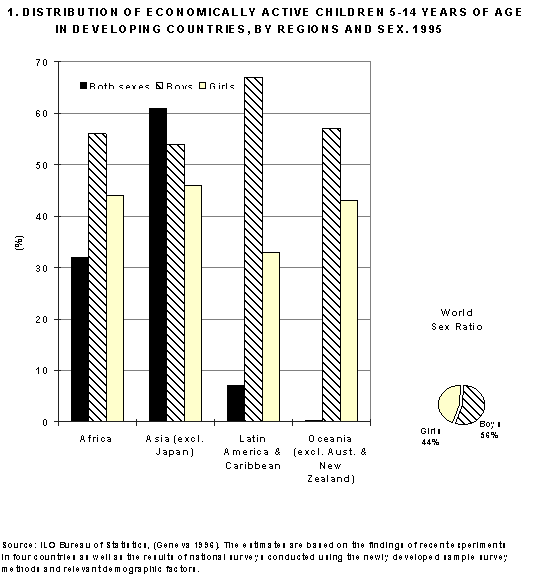
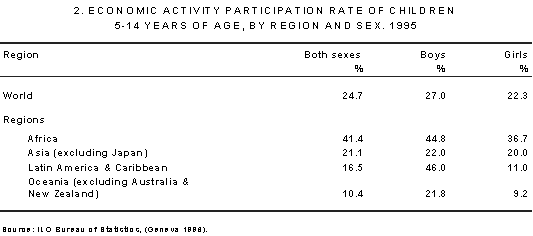
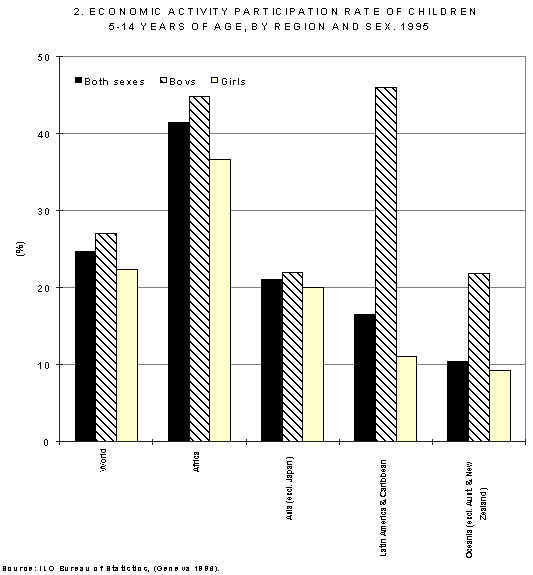
Rural/Urban
Participation rates of children in economic activity are much higher in rural areas
than in urban centres. Based on the surveys so far undertaken, including the experiments
in the four countries, the propensity for children to engage in an economic activity is on
average twice as high in the rural communities. However, with the rapid urbanization of
most developing countries and, also with the increasing number of youngsters themselves
migrating to towns and cities, the share of in the total volume of child labour would the
share of urban centres in the total volume of child labour would no doubt grow steadily in
the future. The vast majority of children working in rural communities are engaged in
agricultural or similar activities (an average of nine out of ten children in most of the
countries surveyed and more than two in every three children in the others). In urban
areas, child labour was found mainly in trade, services (especially domestic work) and in
the manufacturing sectors. Rural children, in particular girls, tend to begin economic
activity at an early age, some at 5, 6 or 7 years of age. Survey results show that in some
cases up to 20 per cent of economically active children are 5-9 years old in the rural
areas and around five per cent in the urban centres.
Industry and occupation
It is evident that the less developed a country is, the greater the proportion of the
child population who work. It is also clear that the more elementary the type of economic
activity or the kind of occupation that does not need specific skills, the larger the
relative size of the working children in that particular industry or occupation. These
factors influence the level of distribution of the total number of working children by
branch of economic activity or by occupation in any specific country. As a result, the
relative level of the child workforce in any industry or occupation could vary widely from
one country to another. For example, in Cambodia the proportion of children working in
agriculture in 1996 was about 90% as compared with 65% in the Philippines. On the other
hand, the level of working children in wholesale and retail trade, restaurants and hotels
was 17% in the Philippines and 7% in Cambodia. Because of the predominance of agriculture
in Cambodia, the number of children working in agriculture-related occupations was also
close to 90% as compared with 75% in the Philippines.
Based on a number of countries (approx. 20) for which data have been collected
recently, the average level of working children in the different branches of economic
activity and occupations are shown in the following two tables and charts:
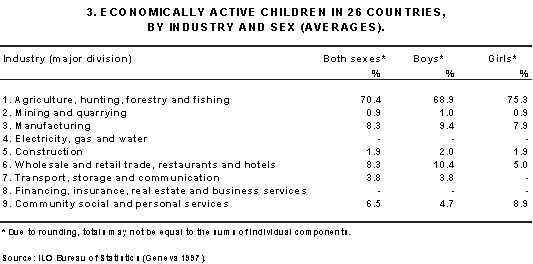
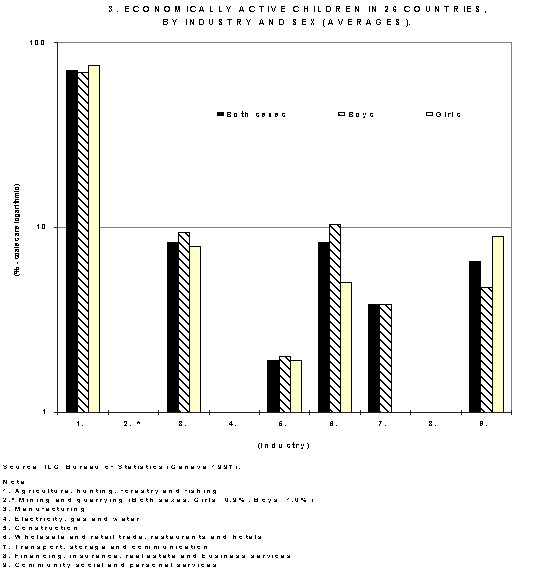

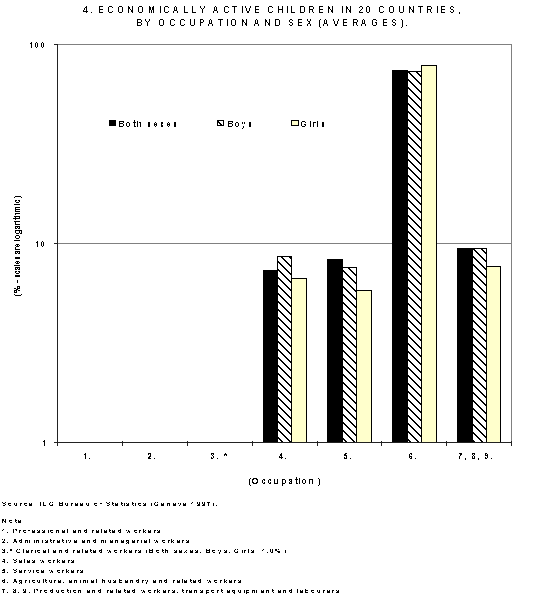
As can be seen, economic activities and occupations related to the agricultural sector
are predominant in the proportion of child workers. Although the average number of
children in agricultural activities and occupations are, respectively, 70% and 74%, these
ratios could be as high as 90% in the former and 95% in the latter. In both, the ratios
for the girls (75% and 79%) are higher than for the boys (69% and 73%).
The proportions of children working in trade, restaurants and hotels (ranging from 8%
to 17% in a few instances), manufacturing (8% to 15%), and services (7%) are relatively
high when compared with the ratios in the other non-agricultural sectors. Most of the
former activities are performed in the urban centres.
Hours and Earnings
Many children work long hours every day of the week. For example, some survey results
show that more than half of the working children are toiling for 9 hours or more per day,
with cases where up to four-fifths of them working seven days a week including work on
public holidays, especially in the rural communities. There are cases where children work
56 hours or more per week. In paid employment which is concentrated in urban centres, the
number of children working long hours is smaller (about two-thirds of them) and the
majority work six days a week.
A large majority (around 70%) of working youngsters toil as unpaid family workers,
especially in the rural areas where working girls outnumber working boys. More than four
in every five children (or 81%) work without pay. Most of those working as paid employees
are paid much less than the prevailing rates in their localities, even when compared with
the legal minimum wages, receiving only one-sixth of the minimum rate in one survey
finding. Also the younger the working child, the lower the wage payment. On average, girls
work longer hours than boys and are paid less than their working brothers doing the same
type of work. Comparatively larger numbers of girls work as paid domestics where the pay
scale is usually low. Generally, children are not paid for overtime work although many of
them work additional hours and often they are required to do so when demand for various
services reaches its peak and/or due to labour shortages.
Many children work during the evenings or nights as well. In one major survey, close to
two-thirds (64%) of the child labour force in the agricultural sector are found to be
working during these periods - three-quarters of the boys and more than two-fifths of the
girls. However, in the retail trade and particularly in personal services, the proportions
of the girls working in the evenings and nights are considerably greater than those of the
boys - 27% as compared with 10% in the former sector, and 16% against 3% in the latter. A
large number of the girls working as housemaids are often obliged to spend the night in
their employer's household thereby also exposing themselves to various abuses, especially
sexual.
II. HAZARDOUS CHILD LABOUR
Being tender physically, children are susceptible to various work -related injuries and
illnesses more than adults doing the same kind of work. Also because they are not yet
matured mentally, they are less aware, even completely unaware, of the potential risks
involved in their specific occupations or at the workplace itself. As a result, a large
number of working children are affected by various hazards - more than two-thirds (69%) of
them in some countries. Many of them suffer actual injuries or illnesses, from 5% to more
than 20%, some of whom stop working permanently.
Recent surveys at the national level have demonstrated that a very high proportion of
the children were physically injured or fell ill while working. These included punctures,
broken or complete loss of body parts, burns and skin disease, eye and hearing impairment,
respiratory and gastro-intestinal illnesses, fever, headaches from excessive heat in the
fields or in factories,... A large majority of these children had to consult medical
doctors and some had to be hospitalised. Many affected children had to miss work for a
time, with some stopping work for good.
In absolute terms, more boys than girls are affected by injuries and illnesses mainly
because of the total size of working boys - (the ratio is almost three working boys to two
girls). Also, since a large majority of working children are in the rural areas engaged in
agricultural activities, the number of injuries and illnesses related to the agricultural
sector is by far the largest. However, in certain specific economic activities or
occupations, the incidence of injuries and illnesses is significantly higher for the
working girls than for their working brothers.
Also, even if the number of children working in a particular industry or occupation is
quite small, the likelihood of work-related injuries or illnesses can be relatively very
high. Therefore, such industries and occupations should be out of the reach of the child
labour force even if allowed to work. For example, as shown in Table 3 and the tables and
charts below, the total number of youngsters who work in the agricultural sector represent
more than two-thirds (70%) of the total working children and, as a result of this large
number, those who experience injuries and illnesses in the sector also account for a
considerably high proportion (70%) of the total suffered by all working children. The
corresponding injury illness levels by gender in the sector are approximately 76% of the
total working boys in all sectors and 57% of the total working girls.
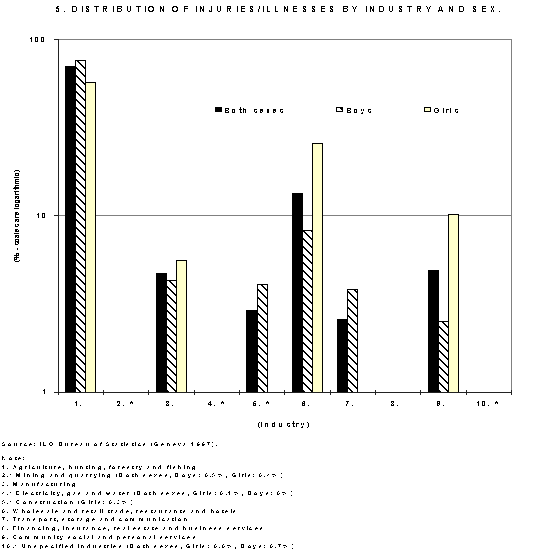

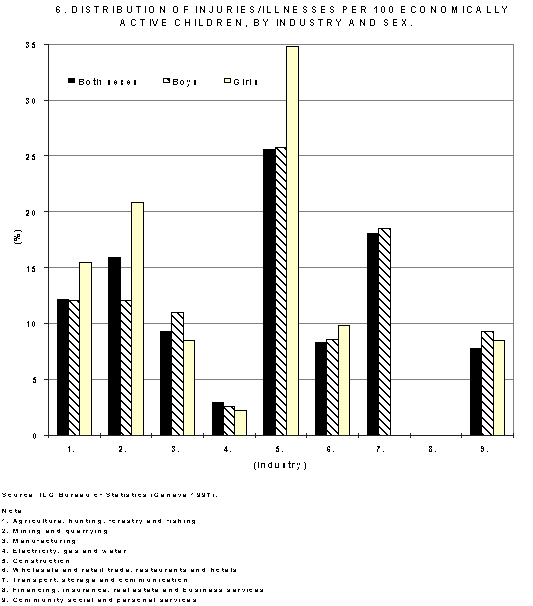
In contrast, the incidence of injuries and illnesses in the sector is 12% of the total
children working in the sector, the same level for the boys and 16% for the girls.
Although the size of child labour in mining or in construction is very small
(respectively, about 1% and 2% of the total child workforce), the occurrence of injuries
and illnesses is significantly high in both sectors. These two are by far the worst
sectors for working children, particularly for the working girls - more than one girl in
every three (35%) and one boy out of four (26%) are affected by injuries and illnesses if
they work in the construction sector; and if working in mining, the incidence is one in
every five girls (21%) and a little more than one boy out of six (16%). While the total
size of workers in the transport sector is also very small (less than 4% of all child
workforce), about one in every five (19%) of the boys working in the sector suffer from
work-related injuries and illnesses which is the second highest for the boys working in
any other sector.
In one recent large survey undertaken at the national level for
probing into all dimensions of child labour for the age-group 5-17 years, much information
was collected particularly on the health and safety aspects of working children. The
results revealed that out of a total of 3.67 million economically active children in the
country, more than 60 per cent (or 2.21 million) were exposed to hazardous conditions
which included biological (19% of all working children), chemical (26%) and environmental
(51%) hazards (Endnote 1)
during their work. Not only because a large majority of children work in agriculture
and related activities, but also due to the hard working conditions in this sector and in
mining, much of the exposure to injuries and illness took place in the rural areas -
approximately two-thirds of all exposures as compared to about one-third in the urban
centres. Again because of their large number, most of those exposed were boys
(approximately 70% of the total working boys and girls); but in relative terms, the level
of exposure was close between the two sexes - 64% of the working boys compared with 53% of
the working girls.
Of the total exposed children of 2.21 million, there were more than 870,000 children
(39%) who suffered injuries or illnesses - divided almost
equally: 49% of them were injuries and the other 51% were illnesses. This amounted to
almost one child in every four children economically active (or 24% of 3.67 million). The
number of boys who suffered was considerably larger than that of the girls (72% verses 28%
of the total sufferers); but the ratios were closer when compared within the same sex (26%
of the working boys and 19% of the girls). Close to three-quarters (74%) of the injuries
and illnesses were in the rural communities and the rest (26%) in the urban areas.
Numerically, the most frequent injuries were cuts/wounds/punctures which totalled close
to 600,000 (or 69% of all injuries). However, there were also injuries which were much
serious though their occurrences were less frequent - for example, burns (57,500,
equivalent to 7% of the total injuries), dislocations/fractures/sprains (45,900, or 6%),
crushing injuries (29,800, or 3%), and even amputation/loss of body parts (1,100, or
one-tenth of one percent) - for a total of 134,300, equivalent to more than 15% of the
total injuries and about four per cent of the total working children. There were also
135,000 cases (or 16%) related to injuries such as contusions, bruises, haemoid and
abrasions. Other injuries totalled 22,400. Together, these injuries affected some 428,000
children, or close to 12% of all the children engaged in economic activity.
Among the illnesses reported, body aches/pains (head, neck, back, etc.) were the most
frequent (518,000, representing 57% of all illnesses), followed by skin diseases (190,000,
or 21%). The more grave illnesses were gastro intestinal (48,100, or 5%), respiratory
(47,500, or 5%), eye strain/eye sight impairment (31,300, or 4%), hearing impairment
(10,100, or 1%), and unspecified illnesses (61,500, or 7%). The number of children who
suffered these illnesses totalled 441,200, or approximately 12% of all the economically
active children.
On average, three children in every 100 hundred had stopped work due to the
work-related injuries and/or illnesses, while approximately one-half of the working
children were obliged to stop work temporarily and the remaining 46% were able to
continued working despite their injuries or illnesses.
III. SUMMARY
Some indicators of the extent of child labour and related variables in countries where
national surveys were conducted recently.
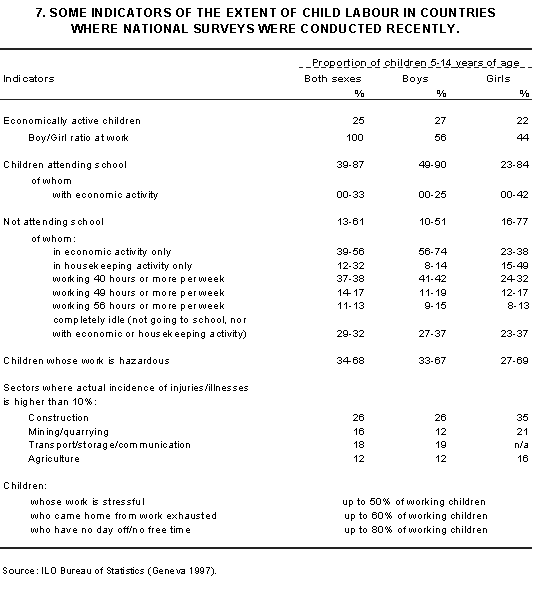
Endnote 1:
Biological includes: viral, bacterial, fungal, parasitic, etc; chemicals: liquid (oil,
gasolin, mercury), mist fumes, vapors (paint, insecticide, pesticide), gas (oxygen,
ammonia); and environmental: radiation/ultraviolet/microwave, temperature/humidity,
pressure, illumination.
|
 International
International